Case Study Analysis: Motivation Theories and Jack's Store Application
VerifiedAdded on 2020/12/09
|7
|1433
|127
Case Study
AI Summary
This case study examines motivation theories, focusing on the application of ERG (Existence, Relatedness, Growth) and Herzberg's Two-Factor theories within Jack's Store, a discount retail outlet. The analysis explores how these theories can be implemented to enhance employee motivation and job satisfaction. The report details the advantages and disadvantages of each theory and provides practical recommendations for Jack's Store to improve employee engagement and retention. The study emphasizes the importance of addressing both hygiene factors (e.g., working conditions, salary) and motivational factors (e.g., achievement, recognition, personal growth) to create a positive work environment and improve overall organizational performance. The conclusion highlights the vital role of motivation in influencing employee behavior and achieving organizational objectives, emphasizing the need for businesses to apply various motivational theories to boost profitability and minimize absenteeism.
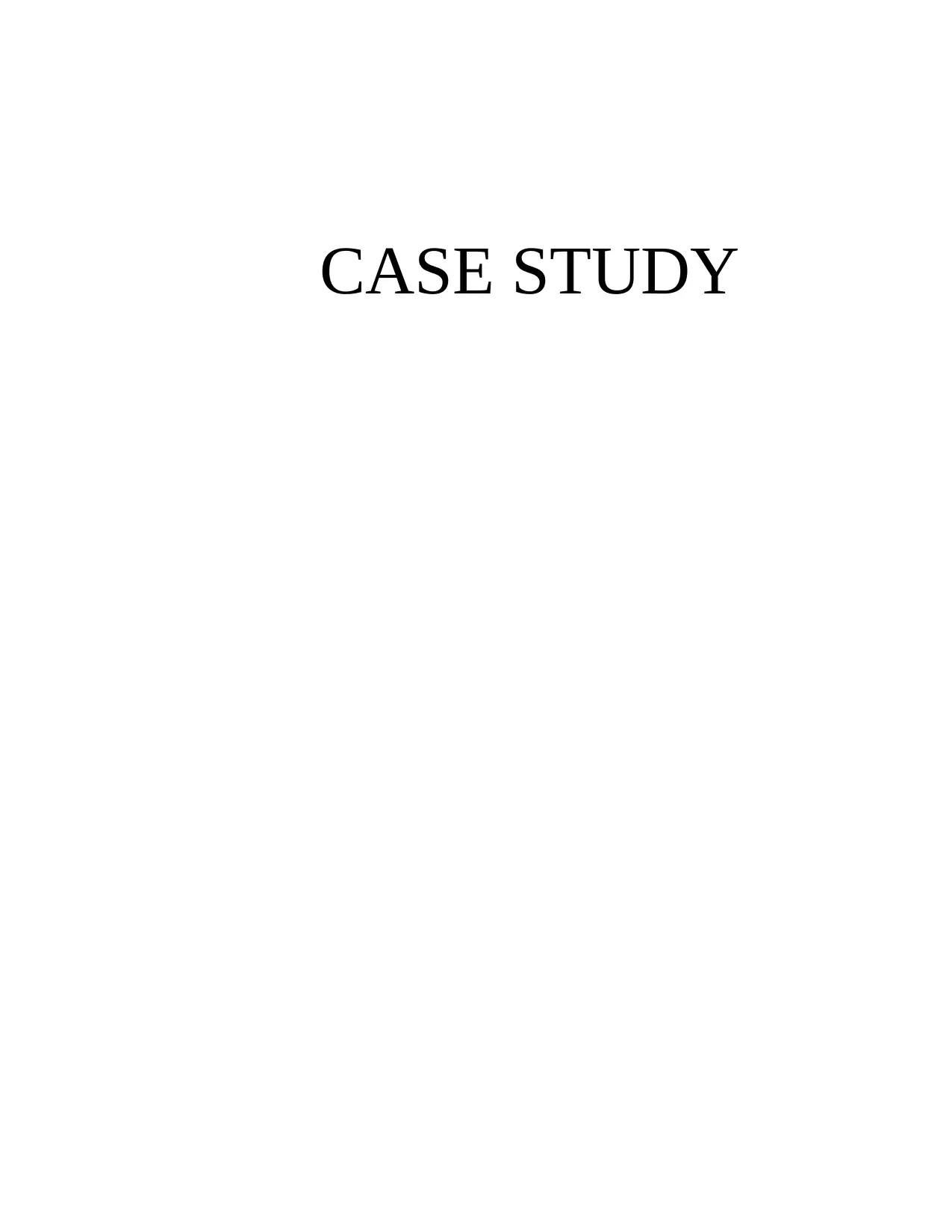
CASE STUDY
Paraphrase This Document
Need a fresh take? Get an instant paraphrase of this document with our AI Paraphraser
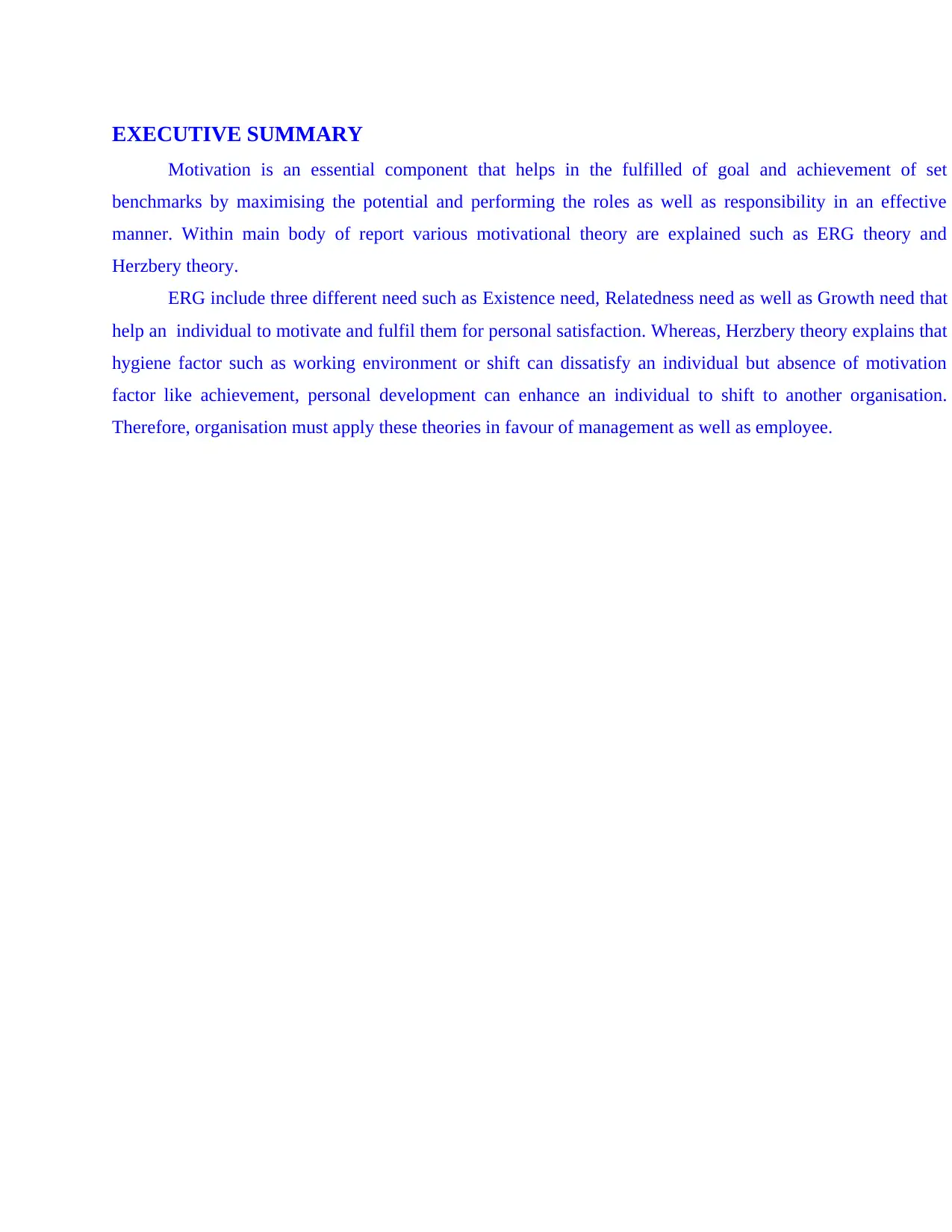
EXECUTIVE SUMMARY
Motivation is an essential component that helps in the fulfilled of goal and achievement of set
benchmarks by maximising the potential and performing the roles as well as responsibility in an effective
manner. Within main body of report various motivational theory are explained such as ERG theory and
Herzbery theory.
ERG include three different need such as Existence need, Relatedness need as well as Growth need that
help an individual to motivate and fulfil them for personal satisfaction. Whereas, Herzbery theory explains that
hygiene factor such as working environment or shift can dissatisfy an individual but absence of motivation
factor like achievement, personal development can enhance an individual to shift to another organisation.
Therefore, organisation must apply these theories in favour of management as well as employee.
Motivation is an essential component that helps in the fulfilled of goal and achievement of set
benchmarks by maximising the potential and performing the roles as well as responsibility in an effective
manner. Within main body of report various motivational theory are explained such as ERG theory and
Herzbery theory.
ERG include three different need such as Existence need, Relatedness need as well as Growth need that
help an individual to motivate and fulfil them for personal satisfaction. Whereas, Herzbery theory explains that
hygiene factor such as working environment or shift can dissatisfy an individual but absence of motivation
factor like achievement, personal development can enhance an individual to shift to another organisation.
Therefore, organisation must apply these theories in favour of management as well as employee.
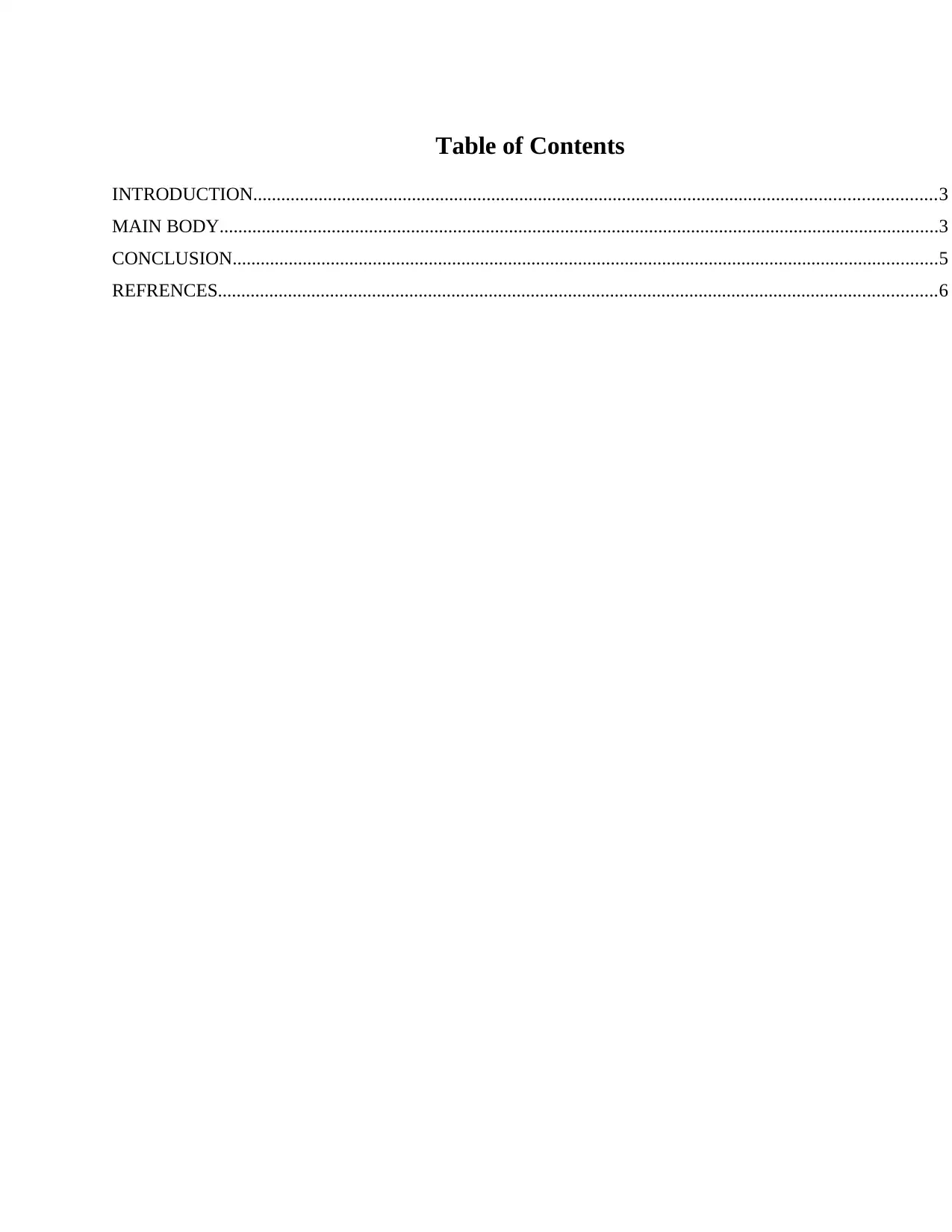
Table of Contents
INTRODUCTION..................................................................................................................................................3
MAIN BODY..........................................................................................................................................................3
CONCLUSION.......................................................................................................................................................5
REFRENCES..........................................................................................................................................................6
INTRODUCTION..................................................................................................................................................3
MAIN BODY..........................................................................................................................................................3
CONCLUSION.......................................................................................................................................................5
REFRENCES..........................................................................................................................................................6
⊘ This is a preview!⊘
Do you want full access?
Subscribe today to unlock all pages.

Trusted by 1+ million students worldwide
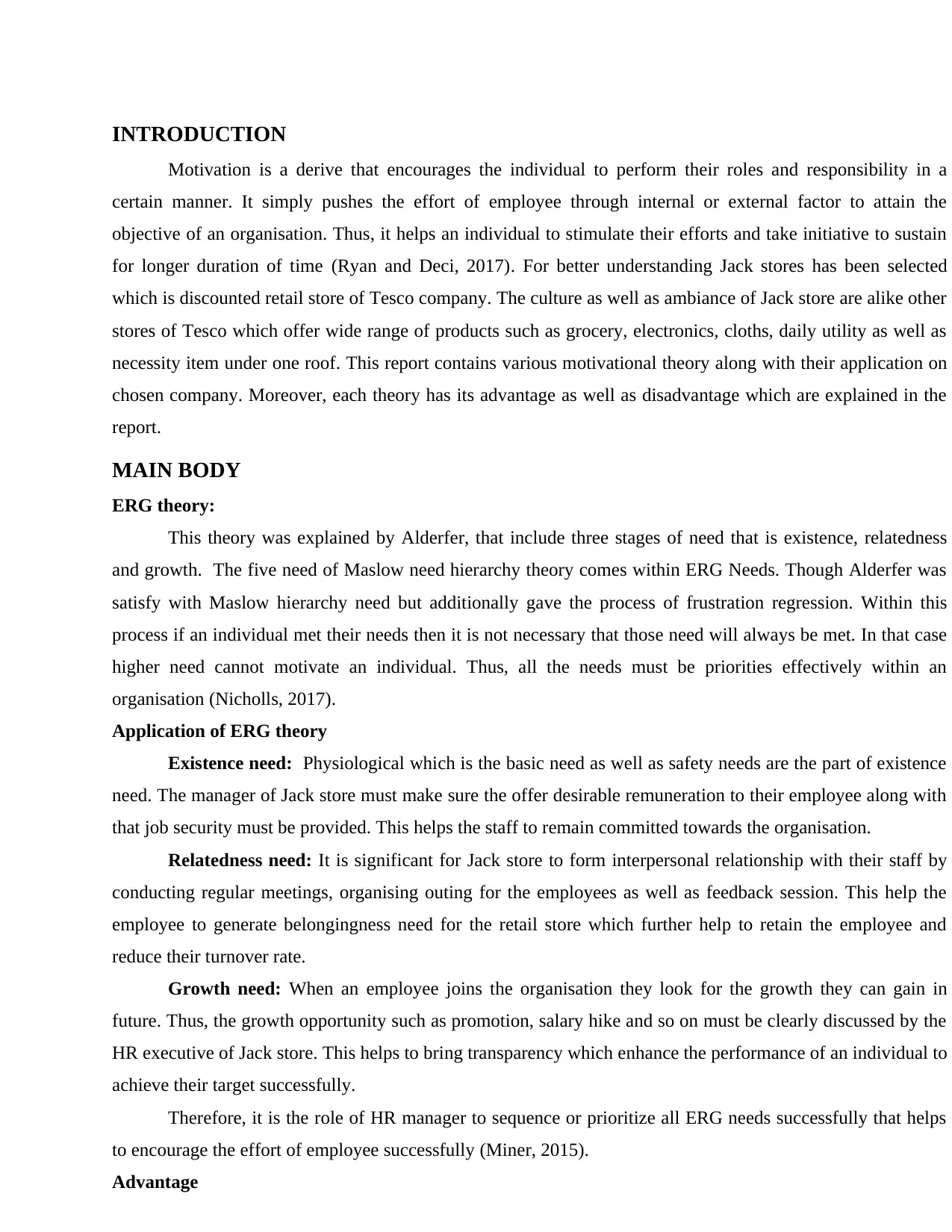
INTRODUCTION
Motivation is a derive that encourages the individual to perform their roles and responsibility in a
certain manner. It simply pushes the effort of employee through internal or external factor to attain the
objective of an organisation. Thus, it helps an individual to stimulate their efforts and take initiative to sustain
for longer duration of time (Ryan and Deci, 2017). For better understanding Jack stores has been selected
which is discounted retail store of Tesco company. The culture as well as ambiance of Jack store are alike other
stores of Tesco which offer wide range of products such as grocery, electronics, cloths, daily utility as well as
necessity item under one roof. This report contains various motivational theory along with their application on
chosen company. Moreover, each theory has its advantage as well as disadvantage which are explained in the
report.
MAIN BODY
ERG theory:
This theory was explained by Alderfer, that include three stages of need that is existence, relatedness
and growth. The five need of Maslow need hierarchy theory comes within ERG Needs. Though Alderfer was
satisfy with Maslow hierarchy need but additionally gave the process of frustration regression. Within this
process if an individual met their needs then it is not necessary that those need will always be met. In that case
higher need cannot motivate an individual. Thus, all the needs must be priorities effectively within an
organisation (Nicholls, 2017).
Application of ERG theory
Existence need: Physiological which is the basic need as well as safety needs are the part of existence
need. The manager of Jack store must make sure the offer desirable remuneration to their employee along with
that job security must be provided. This helps the staff to remain committed towards the organisation.
Relatedness need: It is significant for Jack store to form interpersonal relationship with their staff by
conducting regular meetings, organising outing for the employees as well as feedback session. This help the
employee to generate belongingness need for the retail store which further help to retain the employee and
reduce their turnover rate.
Growth need: When an employee joins the organisation they look for the growth they can gain in
future. Thus, the growth opportunity such as promotion, salary hike and so on must be clearly discussed by the
HR executive of Jack store. This helps to bring transparency which enhance the performance of an individual to
achieve their target successfully.
Therefore, it is the role of HR manager to sequence or prioritize all ERG needs successfully that helps
to encourage the effort of employee successfully (Miner, 2015).
Advantage
Motivation is a derive that encourages the individual to perform their roles and responsibility in a
certain manner. It simply pushes the effort of employee through internal or external factor to attain the
objective of an organisation. Thus, it helps an individual to stimulate their efforts and take initiative to sustain
for longer duration of time (Ryan and Deci, 2017). For better understanding Jack stores has been selected
which is discounted retail store of Tesco company. The culture as well as ambiance of Jack store are alike other
stores of Tesco which offer wide range of products such as grocery, electronics, cloths, daily utility as well as
necessity item under one roof. This report contains various motivational theory along with their application on
chosen company. Moreover, each theory has its advantage as well as disadvantage which are explained in the
report.
MAIN BODY
ERG theory:
This theory was explained by Alderfer, that include three stages of need that is existence, relatedness
and growth. The five need of Maslow need hierarchy theory comes within ERG Needs. Though Alderfer was
satisfy with Maslow hierarchy need but additionally gave the process of frustration regression. Within this
process if an individual met their needs then it is not necessary that those need will always be met. In that case
higher need cannot motivate an individual. Thus, all the needs must be priorities effectively within an
organisation (Nicholls, 2017).
Application of ERG theory
Existence need: Physiological which is the basic need as well as safety needs are the part of existence
need. The manager of Jack store must make sure the offer desirable remuneration to their employee along with
that job security must be provided. This helps the staff to remain committed towards the organisation.
Relatedness need: It is significant for Jack store to form interpersonal relationship with their staff by
conducting regular meetings, organising outing for the employees as well as feedback session. This help the
employee to generate belongingness need for the retail store which further help to retain the employee and
reduce their turnover rate.
Growth need: When an employee joins the organisation they look for the growth they can gain in
future. Thus, the growth opportunity such as promotion, salary hike and so on must be clearly discussed by the
HR executive of Jack store. This helps to bring transparency which enhance the performance of an individual to
achieve their target successfully.
Therefore, it is the role of HR manager to sequence or prioritize all ERG needs successfully that helps
to encourage the effort of employee successfully (Miner, 2015).
Advantage
Paraphrase This Document
Need a fresh take? Get an instant paraphrase of this document with our AI Paraphraser
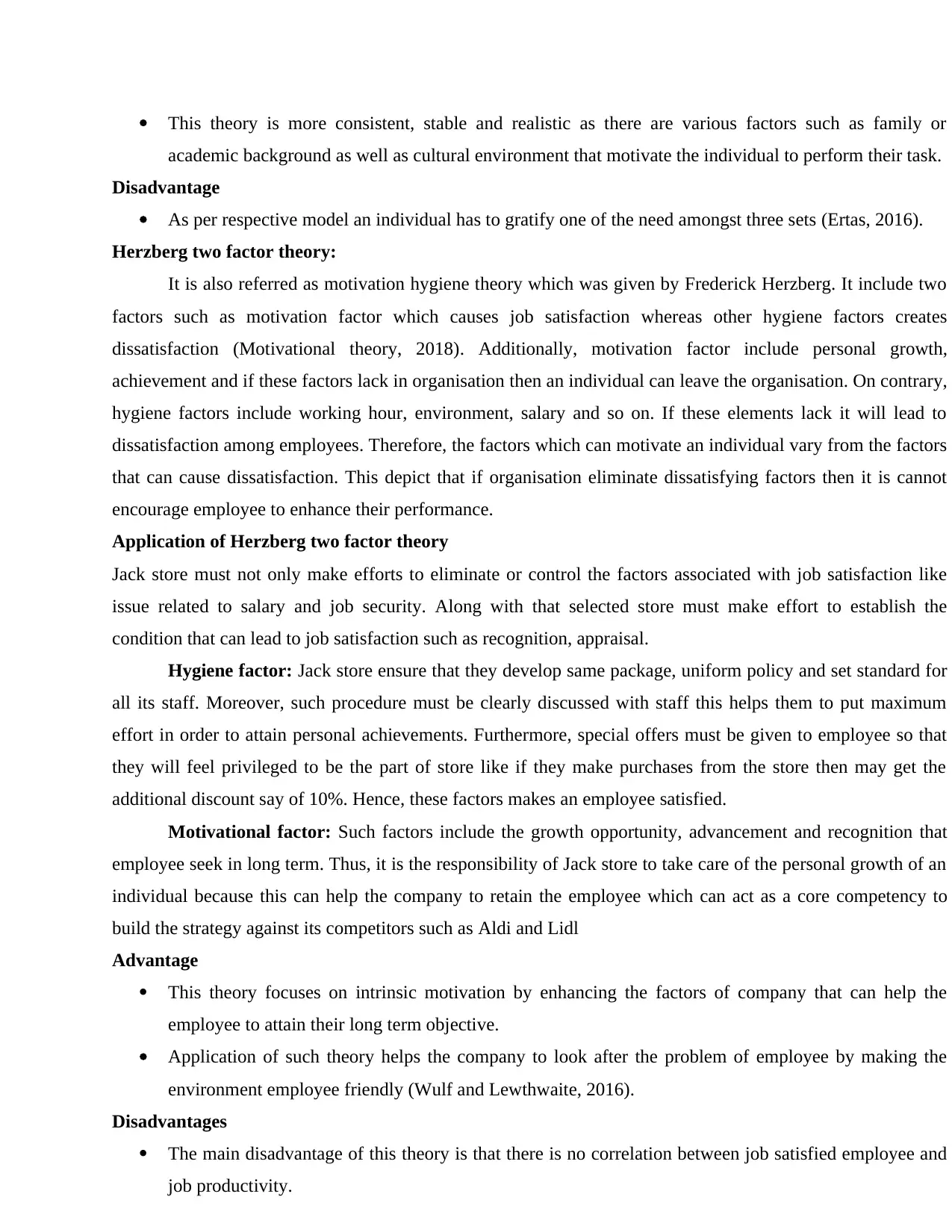
This theory is more consistent, stable and realistic as there are various factors such as family or
academic background as well as cultural environment that motivate the individual to perform their task.
Disadvantage
As per respective model an individual has to gratify one of the need amongst three sets (Ertas, 2016).
Herzberg two factor theory:
It is also referred as motivation hygiene theory which was given by Frederick Herzberg. It include two
factors such as motivation factor which causes job satisfaction whereas other hygiene factors creates
dissatisfaction (Motivational theory, 2018). Additionally, motivation factor include personal growth,
achievement and if these factors lack in organisation then an individual can leave the organisation. On contrary,
hygiene factors include working hour, environment, salary and so on. If these elements lack it will lead to
dissatisfaction among employees. Therefore, the factors which can motivate an individual vary from the factors
that can cause dissatisfaction. This depict that if organisation eliminate dissatisfying factors then it is cannot
encourage employee to enhance their performance.
Application of Herzberg two factor theory
Jack store must not only make efforts to eliminate or control the factors associated with job satisfaction like
issue related to salary and job security. Along with that selected store must make effort to establish the
condition that can lead to job satisfaction such as recognition, appraisal.
Hygiene factor: Jack store ensure that they develop same package, uniform policy and set standard for
all its staff. Moreover, such procedure must be clearly discussed with staff this helps them to put maximum
effort in order to attain personal achievements. Furthermore, special offers must be given to employee so that
they will feel privileged to be the part of store like if they make purchases from the store then may get the
additional discount say of 10%. Hence, these factors makes an employee satisfied.
Motivational factor: Such factors include the growth opportunity, advancement and recognition that
employee seek in long term. Thus, it is the responsibility of Jack store to take care of the personal growth of an
individual because this can help the company to retain the employee which can act as a core competency to
build the strategy against its competitors such as Aldi and Lidl
Advantage
This theory focuses on intrinsic motivation by enhancing the factors of company that can help the
employee to attain their long term objective.
Application of such theory helps the company to look after the problem of employee by making the
environment employee friendly (Wulf and Lewthwaite, 2016).
Disadvantages
The main disadvantage of this theory is that there is no correlation between job satisfied employee and
job productivity.
academic background as well as cultural environment that motivate the individual to perform their task.
Disadvantage
As per respective model an individual has to gratify one of the need amongst three sets (Ertas, 2016).
Herzberg two factor theory:
It is also referred as motivation hygiene theory which was given by Frederick Herzberg. It include two
factors such as motivation factor which causes job satisfaction whereas other hygiene factors creates
dissatisfaction (Motivational theory, 2018). Additionally, motivation factor include personal growth,
achievement and if these factors lack in organisation then an individual can leave the organisation. On contrary,
hygiene factors include working hour, environment, salary and so on. If these elements lack it will lead to
dissatisfaction among employees. Therefore, the factors which can motivate an individual vary from the factors
that can cause dissatisfaction. This depict that if organisation eliminate dissatisfying factors then it is cannot
encourage employee to enhance their performance.
Application of Herzberg two factor theory
Jack store must not only make efforts to eliminate or control the factors associated with job satisfaction like
issue related to salary and job security. Along with that selected store must make effort to establish the
condition that can lead to job satisfaction such as recognition, appraisal.
Hygiene factor: Jack store ensure that they develop same package, uniform policy and set standard for
all its staff. Moreover, such procedure must be clearly discussed with staff this helps them to put maximum
effort in order to attain personal achievements. Furthermore, special offers must be given to employee so that
they will feel privileged to be the part of store like if they make purchases from the store then may get the
additional discount say of 10%. Hence, these factors makes an employee satisfied.
Motivational factor: Such factors include the growth opportunity, advancement and recognition that
employee seek in long term. Thus, it is the responsibility of Jack store to take care of the personal growth of an
individual because this can help the company to retain the employee which can act as a core competency to
build the strategy against its competitors such as Aldi and Lidl
Advantage
This theory focuses on intrinsic motivation by enhancing the factors of company that can help the
employee to attain their long term objective.
Application of such theory helps the company to look after the problem of employee by making the
environment employee friendly (Wulf and Lewthwaite, 2016).
Disadvantages
The main disadvantage of this theory is that there is no correlation between job satisfied employee and
job productivity.
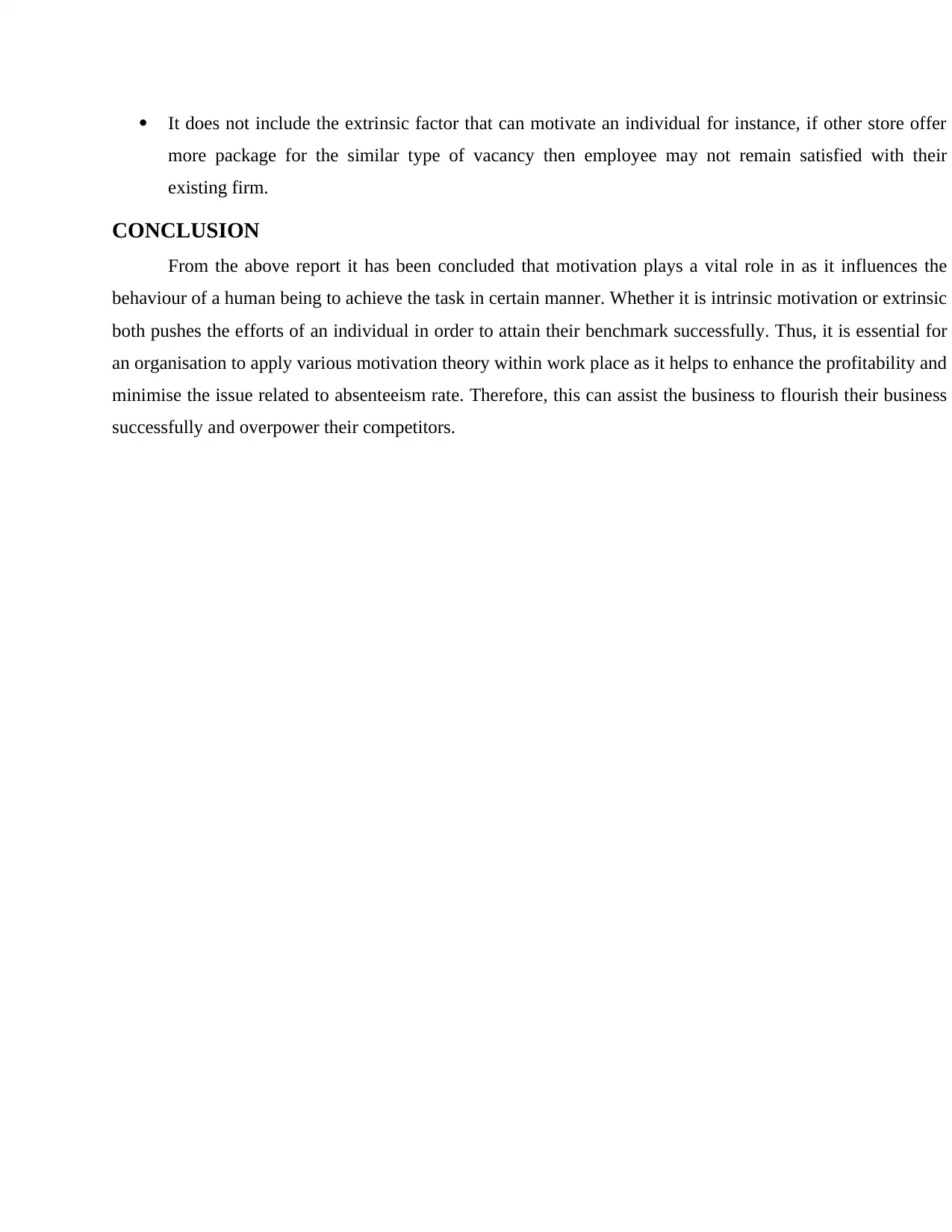
It does not include the extrinsic factor that can motivate an individual for instance, if other store offer
more package for the similar type of vacancy then employee may not remain satisfied with their
existing firm.
CONCLUSION
From the above report it has been concluded that motivation plays a vital role in as it influences the
behaviour of a human being to achieve the task in certain manner. Whether it is intrinsic motivation or extrinsic
both pushes the efforts of an individual in order to attain their benchmark successfully. Thus, it is essential for
an organisation to apply various motivation theory within work place as it helps to enhance the profitability and
minimise the issue related to absenteeism rate. Therefore, this can assist the business to flourish their business
successfully and overpower their competitors.
more package for the similar type of vacancy then employee may not remain satisfied with their
existing firm.
CONCLUSION
From the above report it has been concluded that motivation plays a vital role in as it influences the
behaviour of a human being to achieve the task in certain manner. Whether it is intrinsic motivation or extrinsic
both pushes the efforts of an individual in order to attain their benchmark successfully. Thus, it is essential for
an organisation to apply various motivation theory within work place as it helps to enhance the profitability and
minimise the issue related to absenteeism rate. Therefore, this can assist the business to flourish their business
successfully and overpower their competitors.
⊘ This is a preview!⊘
Do you want full access?
Subscribe today to unlock all pages.

Trusted by 1+ million students worldwide
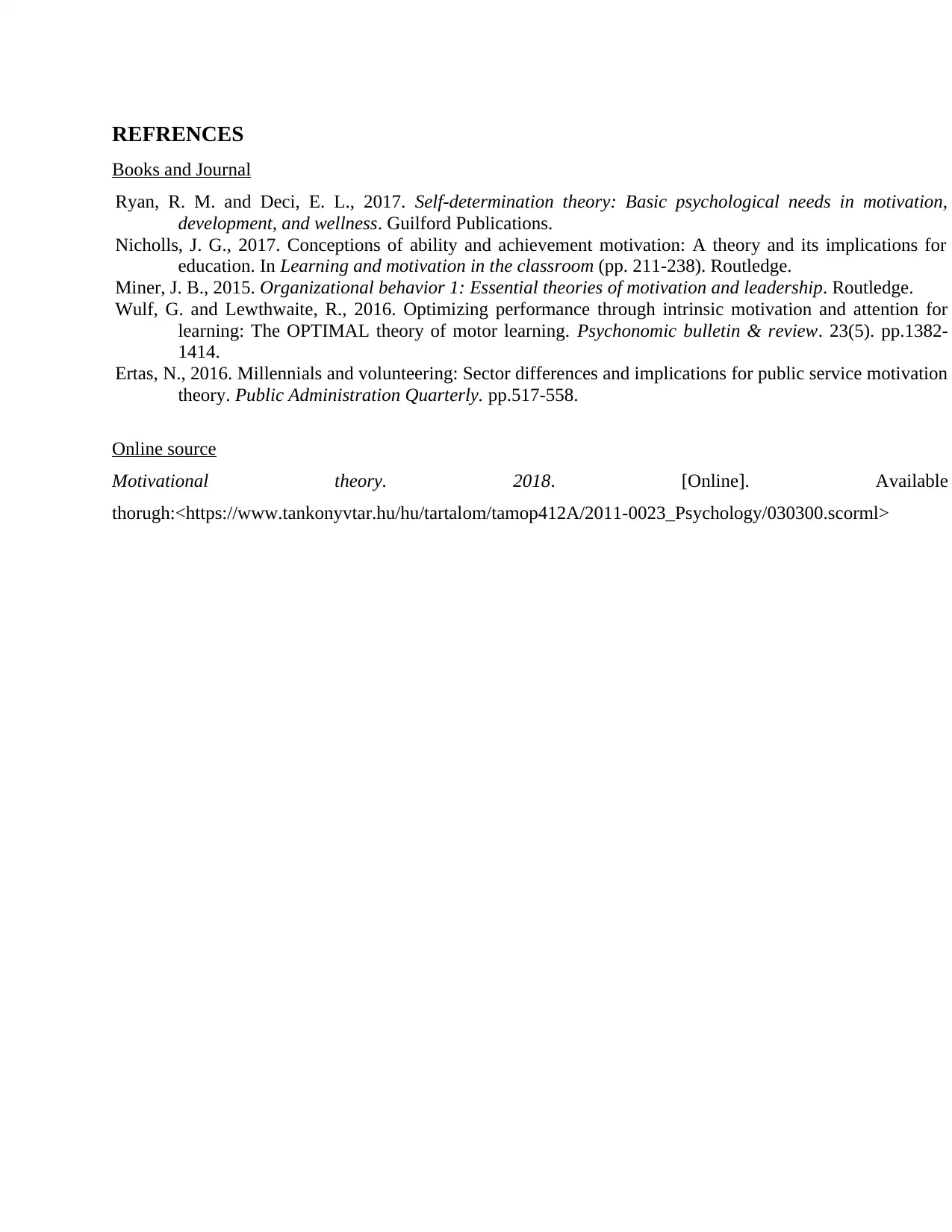
REFRENCES
Books and Journal
Ryan, R. M. and Deci, E. L., 2017. Self-determination theory: Basic psychological needs in motivation,
development, and wellness. Guilford Publications.
Nicholls, J. G., 2017. Conceptions of ability and achievement motivation: A theory and its implications for
education. In Learning and motivation in the classroom (pp. 211-238). Routledge.
Miner, J. B., 2015. Organizational behavior 1: Essential theories of motivation and leadership. Routledge.
Wulf, G. and Lewthwaite, R., 2016. Optimizing performance through intrinsic motivation and attention for
learning: The OPTIMAL theory of motor learning. Psychonomic bulletin & review. 23(5). pp.1382-
1414.
Ertas, N., 2016. Millennials and volunteering: Sector differences and implications for public service motivation
theory. Public Administration Quarterly. pp.517-558.
Online source
Motivational theory. 2018. [Online]. Available
thorugh:<https://www.tankonyvtar.hu/hu/tartalom/tamop412A/2011-0023_Psychology/030300.scorml>
Books and Journal
Ryan, R. M. and Deci, E. L., 2017. Self-determination theory: Basic psychological needs in motivation,
development, and wellness. Guilford Publications.
Nicholls, J. G., 2017. Conceptions of ability and achievement motivation: A theory and its implications for
education. In Learning and motivation in the classroom (pp. 211-238). Routledge.
Miner, J. B., 2015. Organizational behavior 1: Essential theories of motivation and leadership. Routledge.
Wulf, G. and Lewthwaite, R., 2016. Optimizing performance through intrinsic motivation and attention for
learning: The OPTIMAL theory of motor learning. Psychonomic bulletin & review. 23(5). pp.1382-
1414.
Ertas, N., 2016. Millennials and volunteering: Sector differences and implications for public service motivation
theory. Public Administration Quarterly. pp.517-558.
Online source
Motivational theory. 2018. [Online]. Available
thorugh:<https://www.tankonyvtar.hu/hu/tartalom/tamop412A/2011-0023_Psychology/030300.scorml>
1 out of 7
Related Documents
Your All-in-One AI-Powered Toolkit for Academic Success.
+13062052269
info@desklib.com
Available 24*7 on WhatsApp / Email
![[object Object]](/_next/static/media/star-bottom.7253800d.svg)
Unlock your academic potential
Copyright © 2020–2025 A2Z Services. All Rights Reserved. Developed and managed by ZUCOL.





